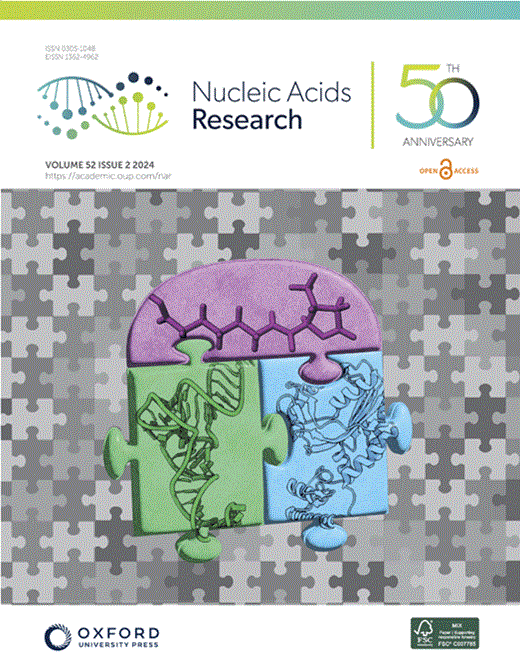III型CRISPR-Cas效应复合物中cA6合成的机制决定因素和动力学
IF 16.6
2区 生物学
Q1 BIOCHEMISTRY & MOLECULAR BIOLOGY
引用次数: 0
摘要
III型集群规则间隔短回文重复序列(CRISPR)和CRISPR相关(Cas)系统(III型CRISPR-Cas系统)使用引导RNA识别外源遗传元件的RNA转录本,从而触发III型效应复合物的Cas10亚基产生环寡腺苷酸(cOA)第二信使。反过来,辅酶辅酶a结合并激活辅助效应蛋白以增强宿主免疫反应。III型系统利用不同的辅酶a,包括环三- (cA3),四- (cA4)和六-腺苷酸(cA6)。然而,决定辅酶a产品身份的分子机制尚不清楚。本研究利用低温电子显微镜观察了意大利肠球菌(Enterococcus italicus, EiCsm) Csm效应复合物合成cA6的机制。我们发现EiCsm利用Cas10 Palm结构域的一组保守结合位点沿3 ‘ -5 ’方向合成低聚腺苷酸核苷酸,以确定新生低聚腺苷酸链的大小。我们的数据还表明,靶RNA结合诱导的构象动力学导致Cas10的变构激活,从而触发低聚腺苷酸的合成。Cas10中一个关键结构元件的突变扰乱了cOA的合成,有利于cA3和cA4的形成。总之,这些结果为III型CRISPR-Cas系统中cOA合成的动力学提供了全面的见解,并揭示了第二信使产物选择性的关键决定因素,从而阐明了其工程的潜在途径。本文章由计算机程序翻译,如有差异,请以英文原文为准。
Mechanistic determinants and dynamics of cA6 synthesis in type III CRISPR-Cas effector complexes
Type III clustered regularly interspaced short palindromic repeats (CRISPR) and CRISPR-associated (Cas) systems (type III CRISPR-Cas systems) use guide RNAs to recognize RNA transcripts of foreign genetic elements, which triggers the generation of cyclic oligoadenylate (cOA) second messengers by the Cas10 subunit of the type III effector complex. In turn, cOAs bind and activate ancillary effector proteins to reinforce the host immune response. Type III systems utilize distinct cOAs, including cyclic tri- (cA3), tetra- (cA4) and hexa-adenylates (cA6). However, the molecular mechanisms dictating cOA product identity are poorly understood. Here we used cryoelectron microscopy to visualize the mechanism of cA6 biosynthesis by the Csm effector complex from Enterococcus italicus (EiCsm). We show that EiCsm synthesizes oligoadenylate nucleotides in 3′–5′ direction using a set of conserved binding sites in the Cas10 Palm domains to determine the size of the nascent oligoadenylate chain. Our data also reveal that conformational dynamics induced by target RNA binding results in allosteric activation of Cas10 to trigger oligoadenylate synthesis. Mutations of a key structural element in Cas10 perturb cOA synthesis to favor cA3 and cA4 formation. Together, these results provide comprehensive insights into the dynamics of cOA synthesis in type III CRISPR-Cas systems and reveal key determinants of second messenger product selectivity, thereby illuminating potential avenues for their engineering.
求助全文
通过发布文献求助,成功后即可免费获取论文全文。
去求助
来源期刊

Nucleic Acids Research
生物-生化与分子生物学
CiteScore
27.10
自引率
4.70%
发文量
1057
审稿时长
2 months
期刊介绍:
Nucleic Acids Research (NAR) is a scientific journal that publishes research on various aspects of nucleic acids and proteins involved in nucleic acid metabolism and interactions. It covers areas such as chemistry and synthetic biology, computational biology, gene regulation, chromatin and epigenetics, genome integrity, repair and replication, genomics, molecular biology, nucleic acid enzymes, RNA, and structural biology. The journal also includes a Survey and Summary section for brief reviews. Additionally, each year, the first issue is dedicated to biological databases, and an issue in July focuses on web-based software resources for the biological community. Nucleic Acids Research is indexed by several services including Abstracts on Hygiene and Communicable Diseases, Animal Breeding Abstracts, Agricultural Engineering Abstracts, Agbiotech News and Information, BIOSIS Previews, CAB Abstracts, and EMBASE.
 求助内容:
求助内容: 应助结果提醒方式:
应助结果提醒方式:


